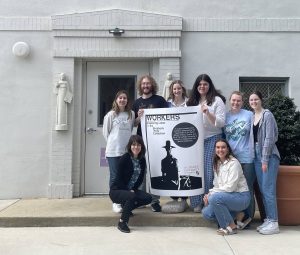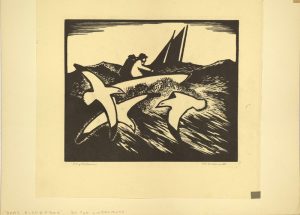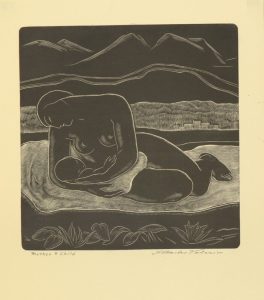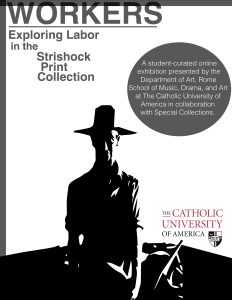This post is by guest blogger Patricia Ortega-Miranda. Patricia Ortega-Miranda is a researcher, lecturer, curator, and Ph.D. Candidate in the Department of Art History & Archeology at the University of Maryland, College Park. She earned her Master’s degree in Art History from the University of Texas at Austin, and has held fellowships from important institutions such as the Blanton Museum of Art in Austin, Texas; the International Center for the Arts of the Americas at the Museum of Fine Arts, Houston, and the National Portrait Gallery in Washington, DC. Patricia teaches Modern and Contemporary Art at the Catholic University of America and at the University of Maryland, College Park. She has organized various exhibitions featuring the work of internationally recognized contemporary Latin-American artists such as Carlos Martiel, Glenda León, and Daniela Libertad.

WORKERS: Exploring Labor in the Strishock Print Collection is an online exhibition resulting from the collaborative work between students in the Art History Department at Catholic University and Special Collections. The idea of working collaboratively was central to my course Museum & Gallery Practices Today, which introduces students to various aspects of gallery and museum practices through a participatory methodology that seeks to foster collaboration, creativity, and criticality. In this course, students develop practical skills in, and generate critical approaches to, exhibition design and audience engagement programs, the two areas most radically impacted by the culture wars of the late 1980s, and the complex and constantly changing social and political landscapes that have emerged since. In this course students come into direct contact with the various processes involved in the development of an exhibition, and the idea is that each part of the exhibition would emerge quite organically out of our class discussions and assignments.
We began by conducting preliminary research about the Strishock Print collection itself and with the help of Maria Mazzenga and Shane MacDonald at Special Collections the students were able to inspect a number of these works and discuss the various printmaking techniques employed and how to determine the artistic and technical value of each print. We discovered that the collection contains works from quite a heterogeneous group of artists working in different parts of the world, in different styles and at different time periods. This was both a challenge and an opportunity. A challenge because there was not enough material to focus on a specific moment in this longer and transnational history of modernist printmaking. But it was an opportunity for the students to find connections between works, artists and contexts that were different and distant from one another. Yet, the heterogeneous character of the collection did capture the moment when a lot of European artists and printmakers migrated to the United States at the end of the 19th century. By the 1930s printmaking flourished in the United States, becoming one of the most important artistic and commercial practices all through the 1940s, the 1950s and well into the 1960s. This is the period that scholar Olga Viso calls the Golden Age of American Printmaking, and it is defined as such because of the unprecedented surge we see in printmaking practices and graphic arts in the United States indebted, in great part, to the influx of artists from Europe and the new institutional and commercial avenues for art. Printmaking was the privileged artform for American Modernism and it developed alongside muralism through portfolios, posters and illustrations commissioned by the US government as part of the Works Progress Administration (WPA).

After the preliminary research students began to consider subject matter, and after much consideration they come up with the theme for the exhibition. During our brainstorming sessions students noted the presence of various genre such as landscape and portraiture, and the importance of place and the human figure. The students noticed that there was a connection between the surge in printmaking as an artistic technique in the United States and the fact that as an art form it became accessible to a lot of people. The humbleness of the medium was something the students found important and something that still held relevance today as new technologies promise to democratize art and support social and political causes. The collection’s heterogeneity granted students the opportunity to diversify their selection by considering gender, race, ethnicity, and nationality as identity markers that would enrich their approach to this social, economic, and cultural history of labor. The students identified workers as a historically relevant theme in art and one that was present throughout the collection. They also noted the importance of highlighting the artistic and technical value of the print, and their choices led to incredibly interesting discoveries about the multilayered, complex and at times uneasy history of labor. For example, the environmental, economic, and social impact of the Dust Bowl in the 1930s led many agricultural workers to abandon their farms during the Great Depression. This is explored by Elena Barton and Moira McCoy in the prints by German artist Hans Alexander Muller and American artist Stevan Dohanos. Shannon O’Doherty uncovered the connections between the rising and thriving of consumer culture in New York City during the 1930s and the moment when women started to join the labor force, while Katie Coyle wrote about the fishermen of New England and their struggles sailing on the dory boat.

Alessandro Mastro-Valerio (1945) is a woodcut also featured in the online exhibition.
Woodcut
In some of the students’ selections labor as a subject matter is less conspicuous, yielding new approaches to this theme. Annaliese Haman rescued the work of a printmaker woman whose skills have been widely overlooked. Marian Hebert’s aquatint is not only a masterful print but reveals how the very concept of labor in the United States gave rise to myths and narratives of resilience that emerged with the occupation of the Western lands. From her part, Clara Hodsen brought to light the work of Austrian-Argentine painter and printmaker Mariette Lydis, whose own personal struggles as a bisexual Jewish woman who fled Europe during the first years of Nazi occupation informed the eerie subject matter of her prints. Gender appears as a central theme in the woodcut Mother and child by Alessandro Mastro-Valerio. In her text Elena Barton explains that it presents “motherhood as a symbol of universal beauty and fertility, this print establishes a parallel between breastfeeding and farming as both acts of care and love that connects humans to nature.” To enrich this history of labor students looked beyond the context of the United States and Europe, Connor Robeck’s text about the work of Japanese master ukiyo-e printmaker Utagawa Hiroshige revealed the fascinating story about the 53 stations of the Tokaido. According to Robeck the print shows “a hub of commerce and interchange, but one still deeply connected to the land. People of all kinds come together to trade the fruits of their labor. This was common on the Tokaido, a highly important coastal road that acted as a place for people of all social statuses to travel and do their business. Because the Tokaido was typically traversed by foot, periodic rest stations were constructed. The 53 stations of the Tokaido were popular landmarks, and they proved a popular subject in the arts, as they provided a useful framework for showing their country’s rich culture and natural beauty.” Lastly, Moira McCoy’s text about Charles William Cain’s etching The Mahout explores the theme of labor in India, a colonial context that fascinated Western artists for centuries.

Among the many skills students developed working on this project the most important one was learning to write catalog entries. Although these are short texts, they required a lot of concision and the ability to synthesize. Connor Robeck, a studio art major and art history minor who specializes on digital art created the exhibition’s poster. His technical and artistic skills came through in his subtle and beautiful stylization of a print from the collection, emphasizing the use of stark contrasts that right from the beginning, he noted as a key and unifying element of most printmaking techniques. Since the second part of the course focused on audience engagement and programming, students explored various strategies and ideas for adding a community-focused element within the exhibition. After a brainstorm session, the idea came up to record interviews with workers around campus. In class we discussed the importance of involving public and audiences directly in the development of public programs in the context of museum exhibitions. I have found that working with a specialized collection, like the Strishock Print Collection, on an exhibition centered around the concept of collaborative curation is a powerful tool for teaching. First, because it allows students to come into direct contact with works of art, to understand their material and physical qualities and value in a profound way. And secondly, because it opens a window into the benefits and challenges of working collaboratively towards a common goal, to create something meaningful and valuable that can be shared with a larger audience and used as a teaching tool and to advance scholarship on the interconnected histories of printmaking and labor.
